If your campaigns are costing you more than they’re performing, it’s time to rebuild your strategy, because the issue might be lying in your traffic itself.
Ad fraud has become one of the biggest reasons impacting your campaigns and marketing budgets across walled gardens, open networks, affiliate platforms, apps, and programmatic ecosystems.
The first half of 2025 recorded an average global ad fraud rate of 39.7%, and fraud peaked at 49% in June, the highest in five years. With AI-driven bots, fake users, and manipulated attribution becoming more advanced, the financial impact is far deeper than most marketers realize.
Therefore, to help you get clarity, this guide will help you understand what ad fraud looks like today, where it hides, how it impacts real performance, and what you can do to protect your budgets with the right validation strategies.
What is Ad Fraud?

Ad fraud is the deliberate manipulation of advertising systems to generate illegitimate revenue by simulating real user interactions, such as clicks, installs, or views, without actual consumer interest.
The lost advertising money is not the only obvious impact of fraudulent activities. Since fraudsters manipulate the most important ad performance metrics, they also skew the insights marketers and advertising teams may draw from those metrics. The impact from this, in many cases, leads to a long-term negative impact on the brand’s advertising efforts.
The problem is made worse because of the availability of options for fraudsters.
Let’s look at some of the most common methods and techniques employed by fraudsters to scam honest advertisers.
What are the Different Types of Ad Fraud? [Channel-wise Fraud]
Types of Web Ad Fraud
Web advertising remains one of the most vulnerable digital channels because of the open networks and automated programmatic advertising ecosystem, that makes it challenging to track and verify the legitimacy of each impression and click. Here are the common types of web ad fraud techniques every advertiser must be aware of:
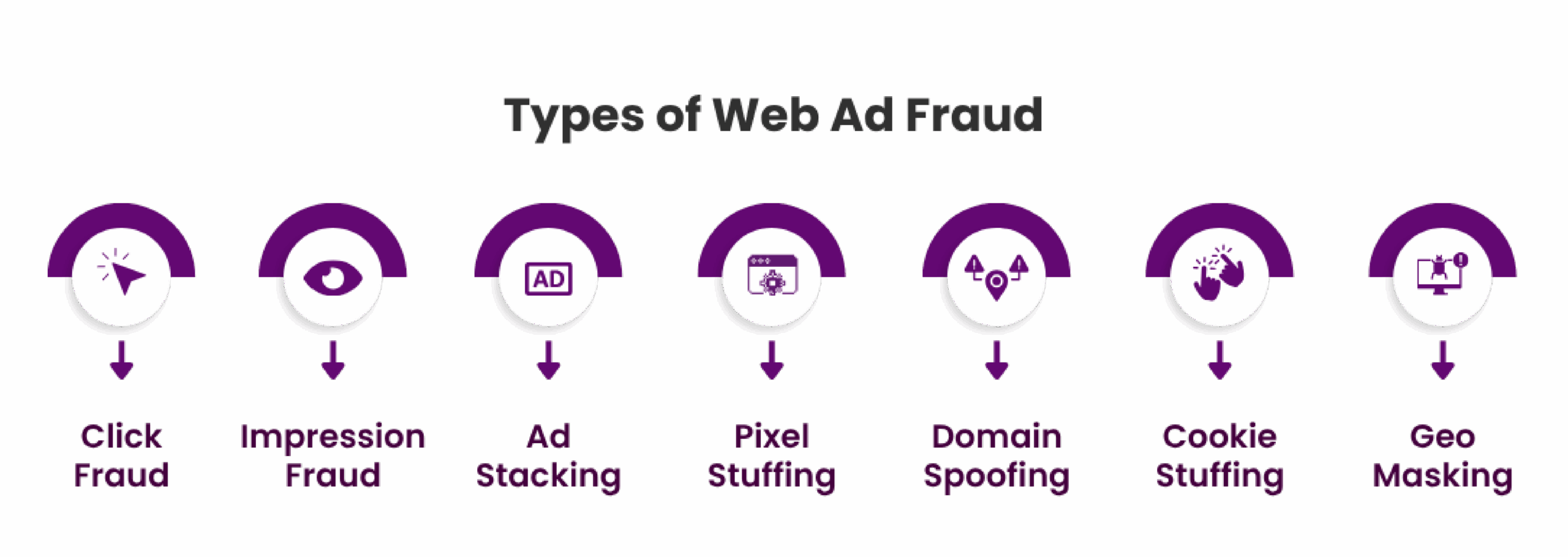
Click Fraud
As the name suggests, click fraud involves generating fake clicks on pay-per-click (PPC) campaigns. Many fraudsters use simple bots to generate these fake clicks. However, most ad networks and platforms can now detect fake clicks coming from simple bots. To overcome this, fraudsters have started developing and deploying sophisticated bots that can mimic human-user behavior and fool the algorithms of the ad platforms.
In some cases, specifically in less developed countries, fraudsters employ cheap labor on “click farms” to generate fake clicks without attracting suspicion from ad networks.
Impression Fraud
Impression fraud involves fraudsters creating fake impressions on ads that pay in exchange for those impressions.
This type of fraud also often involves bots to create fake traffic that can be used to register impressions on ads. Tech-savvy fraudsters may also use more sophisticated methods such as pixel stuffing or ad stacking.
With pixel stuffing, the fraudsters “stuff” the ad into a single pixel on their webpage. This way, when a real user visit said webpage, they don’t see the ad and the fraud publisher still ends up getting paid for that impression.
Similarly, ad stacking involves “stacking” multiple ads on top of each other in a single ad space on the webpage. This way, when the user visits the page, they may see just one ad, but the fraud publisher will get paid for all the ads stacked in the ad space.
Domain Spoofing
Domain spoofing is a type of ad fraud where a fraudster tricks advertisers into thinking their ads are showing on popular, trustworthy websites. However, in reality, the ads run on low-quality MFA (Made for Advertisements) websites or even fake websites. The primary goal is usually to steal sensitive information like login credentials, generate fake leads, and earn money.
In digital terms, the fraudsters change the website’s identity by using a spoofed domain name, elements, and visuals (similar to that of a legitimate website like a well-known press release page) during the ad auction process, so it appears to be a premium site. Advertisers end up paying high prices, thinking their ad is being seen by a valuable audience, but it’s actually wasted on irrelevant or fake traffic, hurting performance, ad budgets, and brand safety.
Cookie Stuffing
Cookie stuffing is one of the common ad fraud tactics used by fraudsters to manipulate affiliate marketing performance. This happens when a fraudulent affiliate secretly “stuffs” or adds multiple affiliate tracking cookies into a user’s browser without their knowledge or action.
These cookies are meant to track if the user later makes a purchase on a brand’s site. If they do, the fraudster earns a commission, even though they didn’t contribute to the sale. It’s like someone secretly putting their referral name on your order so they can get credit. This affiliate fraud tactic hurts brands because it inflates affiliate payouts, messes up marketing data, and steals credit from genuine affiliates who actually put real efforts to earn the sale.
Geo Masking
Geo masking, also known as location fraud, is another type of web ad fraud where the actual location of the user is hidden or faked to make it appear as if they are from a targeted region. Fraudsters use various methods like using proxy servers, or VPNs to route invalid traffic through target locations spoofing GPS data and IP addresses.
Fraudsters do this to trick advertisers into paying higher rates for traffic that looks like it’s genuine, when it’s really coming from irrelevant regions, misleading performance metrics and further campaign optimization.
Types of Mobile Ad Fraud
With the expansive growth in app-based marketing and the complexity of attribution models, mobile apps have become a breeding ground for highly sophisticated ad fraud. These fraud types manipulate app installs, in-app engagements, and user attribution at each stage of the funnel using following techniques:

Install Fraud
Install fraud is a type of mobile ad fraud and involves faking app installs to scam advertisers that operate on cost-per-install (CPI) campaigns.
Fraudsters may employ simple or sophisticated techniques to execute this type of fraud. Simpler techniques involve using real devices and real humans to install applications. Once the reward for the install has been given, the device ID is reset, and the process is repeated. Since the ad network only detects device IDs, this fraud is relatively easy to execute, even with limited tech knowledge.
More sophisticated forms of install fraud involve SDK spoofing. Fraudsters manipulate the SDK, or the software development kit used in creating the app to generate fake install numbers and attribution. This way, fraudsters are able to emulate installs without any actual installs taking place.
Click Injection
A more advanced form of mobile ad fraud, click injection is when a malicious app on a user’s device secretly detects when the user is about to install a new app. Just before the installation finishes, the app quickly sends a fake “click” signal to the ad network, making it seem like the fraudster got the install.
Because many mobile tracking systems credit the most recent click, the fraudster steals the credit for an install that happened naturally or was driven by a legitimate campaign. This type of fraud happens within milliseconds and is difficult to detect without advanced fraud prevention tools, resulting in stolen attribution and wasted marketing spend.
Click Spamming
Click spamming, also known as click flooding or organic poaching, is a sophisticated form of app fraud where fraudsters send a large number of fake “ad click” signals in the background, without the user ever interacting with an ad. These fake clicks are generated through malicious apps or infected SDKs installed on a user’s device. The goal is to trick attribution systems into thinking that the fraudster’s click led to a real app install, especially when the user later downloads an app on their own (organically).
Device Fraud
Device fraud involves manipulating mobile devices and their device identifiers to generate fake ad interactions and revenue. Fraudsters use methods like ID spoofing, device farms, or emulators, to deceive advertisers, making everything look fine on the surface. These deceptive tactics are used to install apps, click on ads, and perform fake actions like sign-ups or in-app events damaging the effectiveness of mobile advertising campaigns.
Incent Fraud
Apps incent fraud is similar to incentivized browsing ad fraud tactic. It involves manipulating ad campaigns by offering users incentives for interacting with ads or installing apps. Unlike legitimate incentivized campaigns where rewards are clearly disclosed, incent fraud often disguises these offers, appearing as genuine user acquisition activities.
Fraudsters exploit this by attracting low-quality users motivated solely by the reward rather than genuine interest in the app or service to artificially boost app installs, engagement metrics, and other campaign data, making it appear that an app or ad is performing better than it truly is.
APK Fraud
APK mobile ad fraud is a technique used by fraudsters to manipulate or distribute unauthorized versions of an Android app’s APK (Android Package Kit) file. In this they create a fake APK file, tamper with it and repackage it with malicious codes to generate fake ad clicks, impressions, or installs. These fake apps are often available on third party app stores or shared through unofficial download links.
When users install these APK files, the malicious code runs in the background, performing fraudulent activities such as fake ad engagement or stealing user data without their consent.
Attribution Fraud
Attribution fraud involves fraudsters manipulating the ad attribution platforms to falsely claim the credit for a conversion or an app install. Most commonly, fraudsters infect user devices with malware to manipulate the last click before the install is complete and claim the credit for the app install. They use the malware to “inject” a click at the very last moment before the app is installed. This method of executing attribution fraud is commonly known as click injection.
Fraudsters may also manipulate in-app events, such as purchases and registrations and attribute those actions to their campaigns.
Retargeting Fraud
Retargeting fraud is quite similar to impression fraud since the execution involves the use of bots to register fake impressions. However, the financial impact of retargeting fraud is much greater than regular impression fraud. This is because the cost of impressions on retargeting ads is much higher and for the fraudsters, the reward for the fraud is also more lucrative.
Types of OTT/CTV Ad Frauds
OTT (Over-the-top) and CTV (Connected TV) advertising is booming and so is fraud in this space. High CPMs, low transparency, and server-side ad insertions make OTT/CTV uniquely susceptible to advanced spoofing and viewability scams. Here are the types of OTT/CTV ad frauds you need to protect your ad campaigns from:
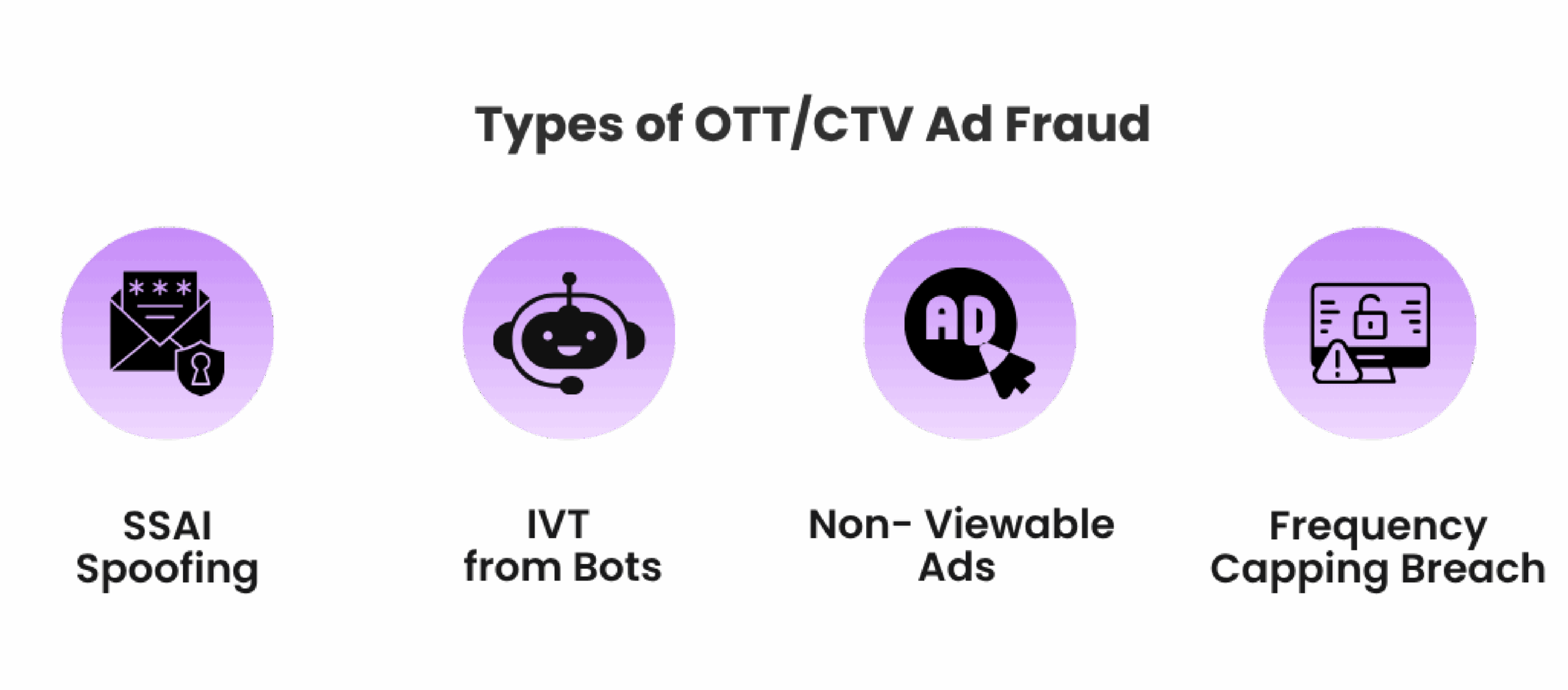
SSAI Spoofing (Server-Side Ad Insertion Fraud)
SSAI spoofing is one of the most common and difficult to detect types of OTT/CTV ad fraud. In server-side ad insertion (SSAI), ads are stitched directly into the video content before it is streamed, making the ad experience seamless. Fraudsters exploit this process by mimicking legitimate SSAI ad requests using fake servers or scripts. These spoofed requests appear genuine to advertisers, making it seem like their ads are being watched by real users, inflating views and impressions.
SSAI spoofing is particularly dangerous because it exploits a trusted part of the CTV ecosystem and can happen at massive scale without raising immediate red flags.
IVT from Bots (Invalid Traffic)
In OTT/CTV fraud, Invalid Traffic (IVT) from bots refers to non-human traffic that simulates user actions such as starting, pausing, or watching videos. These bots are programmed to mimic real viewer behavior, sometimes even including simulated remote-control interactions to fool ad platforms into thinking real users are watching the ads. Fraudsters use this bot activity to generate fake impressions, completion rates, or clicks on interactive CTV ads.
Since CTV environments often lack traditional fraud detection signals (like mouse movement or touch data), bots operate with greater freedom and lower risk of being flagged.
Non-Viewable Ads
Non-viewable ads in the CTV/OTT ecosystem refer to advertisements that technically “play” during content but are never actually seen by a viewer. This happens in several ways: the screen may be off, the video minimized, muted, or running in the background while no one is watching. In some cases, fraudsters load ads in invisible video players or hidden environments where impressions are still counted despite zero visibility.
Because CTV platforms often lack reliable viewability tracking compared to web or mobile, it’s easy for fraudsters to exploit these gaps and serve non-viewable ads at scale. For advertisers, this means paying premium prices for impressions that had no chance of impacting real human behavior.
Frequency Capping Breach
Frequency capping is a setting used by advertisers to limit the number of times the same ad is shown to a single user or device within a given time period. It helps ensure balanced ad exposure, improve user experience, and maximize ROI. It also helps prevent ad fatigue, which occurs when viewers see the same ad too often and become annoyed or disengaged, reducing the effectiveness of the campaign.
However, in OTT/CTV ad fraud, fraudsters breach frequency capping by constantly generating new or spoofed device IDs, making each impression appear as if it’s being served to a different viewer. This tricks the system into resetting the cap, allowing the same ad to be delivered far more times than intended. The result is inflated impression counts, wasted ad spend, and misleading performance data, all while viewers are bombarded with repetitive ads that damage brand perception.
Why Should You Care About Ad Fraud?
Now that we have understood the common methods employed by fraudsters to commit digital ad fraud, let’s look at the impact of these activities:
The Impact:
- $100B+ lost globally – According to Statista, in 2023, advertisers lost $88 billion to ad fraud. This number is expected to grow to a whopping $178 billion in the next four years. Safe to say, the financial impact of ad fraud is enormous.
- False data – When fraudsters manipulate attribution data and performance metrics, it skews the insights that advertisers are able to draw. This, in turn, limits their ability to make positive optimizations to their campaigns.
- Wasted ad spend – Because of instances of fraud, advertisers end up paying huge amounts in advertising fees without getting any real results. This, in the long term, can lead to waning interest in pushing specific services or products through advertising. In the worst cases, such instances can cause brands and advertisers to doubt the efficacy of their digital advertising efforts.
Hidden Costs:
- Damaged brand reputation – Brands who have fallen victim to instances of fraud often find their ads published on fraudulent or malicious websites. Users visiting these websites and viewing these ads may form a negative opinion about the brand, even if they have not purchased from the brand or interacted with them in the past.
- Reduced campaign efficiency – Fake leads, clicks, impressions, and app downloads can easily lead to significant wastage of marketing budgets. Such instances are sure to have a negative impact on the conversion rates of the campaigns, effectively reducing the efficiency of said campaigns.
- Misallocation of marketing budgets – Since the aforementioned fraudulent activities lead to skewing of ad performance metrics, marketers can often find themselves misled. Due to this, they may allocate significant chunks of their marketing budget to publishers that are delivering the best numbers but since the numbers are faked, it prevents them from allocating their budgets to genuine sources supplying authentic leads and conversions.
Ignoring ad fraud isn’t an option anymore—it’s a growth blocker.
Who is Affected by Ad Fraud?
In this section, we will talk about the obvious and the not-so-obvious victims of ad fraud.
Everyone in the Digital Advertising Ecosystem:
- Marketers: Marketers pay for ad fraud in the form of wasted budgets and poor results. These don’t just result in immediate financial loss for the business, it also has an opportunity cost that the business pays because of lost confidence in digital advertising.
- Legitimate Publishers: Legitimate publishers often face unfair competition from fraudulent publishers who use bots, fake traffic, or other deceptive tactics to undercut prices. This directly leads to revenue loss, as advertisers may unknowingly choose cheaper but fraudulent inventory over genuine, high-quality placements. This also results in reputational damage if their inventory gets associated with fraudulent inventory unknowingly. In severe cases, publishers might also face ad network bans, losing access to major monetization platforms if fraud is detected within their traffic, even if it originates from external sources.
- Advertisers: Similar to marketers, advertisers and advertising teams bear the brunt of the impact of ad fraud as they are left to answer for poorly performing campaigns and bad quality leads.
- Agencies: Marketing and advertising agencies depend on campaign performance data to optimize their efforts and drive continuously improving results for their clients. Unfortunately, because of instances of fraud, this data is often compromised, directly affecting the ability of marketing agencies to deliver satisfactory results for their clients.
- Ad Networks & Platforms: Ad networks and platforms act as the bridge between advertisers and publishers, and their credibility depends on delivering genuine results. Ad fraud can lead to trust erosion, where advertisers reduce or withdraw spend if they believe fraud is not being effectively addressed. It also increases operational costs, as networks need to allocate more resources to fraud detection, prevention, and traffic validation. In highly regulated industries and markets, ad fraud can even pose legal or compliance risks.
- Affiliate Managers: Affiliate campaigns are often plagued by a form of ad fraud called incentive fraud. With this, fraudsters incentivize their audience to download an app or complete a certain action that gets them an affiliate reward. The direct impact of this is the large number of disinterested users that were never interested in the product or app. However, these users are real human users that may now associate the brand with unethical practices such as providing incentives to inflate app download numbers. They may even spread their opinions through word-of-mouth and cause serious damage to the brand’s reputation.
Channels Most Vulnerable:
- Affiliate Marketing – Affiliate marketing channels are susceptible to fraud since brands have very little control over the activities of affiliates. At the same time, affiliate marketing, by design, works on an incentive model, which is more than enough reason for affiliates with loose morals and ethics to commit fraud. Finally, executing fraudulent schemes and techniques is relatively simple in the case of affiliate marketing.
- Programmatic Platforms – Programmatic platforms depend on algorithms to run their operations. In theory, algorithms can detect bot activity and prevent fraud. However, from a fraudster’s perspective, it is not difficult to fool algorithms with sophisticated bots or real users employed in click farms.
- OTT & CTV – OTT and CTV platforms are plagued by fraud because the ad delivery involves several platforms and several intermediaries. These factors, combined with access to limited user data because of privacy concerns make it difficult to track and/or prevent instances of fraud.
- Walled Gardens (yes, even there!) – Contrary to popular belief, walled garden advertising ecosystems are not safe from ad fraud. In fact, they are highly prone to fraud because of limited visibility for advertisers and the platforms’ dependence on algorithms.
- Mobile Apps and OEMs – The mobile ad ecosystem is perhaps one of the most complex in the digital ad landscape and hence, there is a serious lack of transparency and fraud detection capabilities of platforms and networks is limited. Moreover, the sheer number of mobile users make mobile ad fraud extremely lucrative for fraudsters.
Here is an analysis by mFilterIt of the invalid traffic across platforms.
Average Invalid Traffic Across Platforms
| PLATFORMS | EUROPE | US | INDIA | MENA |
|---|---|---|---|---|
| Walled Gardens | ||||
| Search | 10% | 9% | 10% | 12% |
| Partner Networks | 18% | 21% | 21% | 23% |
| Social Media Direct | 11% | 7% | 9% | 10% |
| Video | 15% | 15% | 17% | 18% |
| Open Networks | ||||
| Affiliate Networks | 33% | 34% | 43% | 35% |
| Programmatic | 29% | 30% | 31% | 34% |
Where Does Ad Fraud Happen?
Ad Fraud Is Omnichannel:
Ad fraud doesn’t limit itself to a single platform, it infiltrates every corner of the digital ecosystem. Whether it’s mobile apps, websites, connected TVs, or affiliate networks, fraudsters adapt their tactics to exploit vulnerabilities across all channels. This makes it critical for marketers to understand not just that fraud exists, but where it strikes. From spoofed traffic to fake installs and manipulated conversions, each channel presents its own set of risks. The table below outlines the most common fraud techniques across key digital advertising channels.
| Channel | Fraud Techniques |
|---|---|
| App | Install Fraud , OEM manipulation , fake retargeting |
| Web | Fake conversions,Click farms,MFA sites , Organic Poaching |
| CTV | Non-viewable ads,Traffic spoofing |
| OTT | Fake impressions , non-contextual placements |
| Affiliate | Brand safety issues , incentive fraud , organic traffic hijacking |
Even premium platforms can’t guarantee fraud-free delivery.
How to Know if Your Campaign is Impacted by Ad Fraud?
Ad fraud often goes unnoticed until budgets are drained and performance metrics stop adding up. Knowing the warning signs can help you act fast and safeguard your marketing spend. Here’s what to watch for:
Watch Out for These Red Flags:
Abnormally high click or install rates
If a campaign is generating an unusually high number of clicks or installs compared to impressions or spend, it’s a strong sign that something is off. Fraudsters often use bots or click farms to simulate user activity and inflate metrics. These fake engagements may look impressive at a glance but often fail to drive real conversions or business outcomes.
Low retention and high uninstall rates
Legitimate users don’t usually uninstall an app within minutes or hours of installing it. If your data shows that a significant percentage of users are abandoning the app shortly after installation, or not returning after the first day, it may indicate that those installs are fraudulent or incentivized. Fraudulent installs often show poor user quality because there are no genuinely interested users initiating them.
Attribution discrepancies
If your attribution data doesn’t line up with other analytics tools—or if there are sudden shifts in attributed traffic without a corresponding change in campaign strategy—this could point to fraud. Fraudsters may manipulate attribution using techniques like click injection or SDK spoofing to claim credit for installs they didn’t drive, causing chaos in your reporting and optimizations.
High bounce or low engagement from costly sources
When you’re spending heavily on a particular traffic source but seeing very short sessions, minimal page views, or low in-app activity, it’s time to dig deeper. Fraudulent traffic often mimics user actions just enough to get past basic filters but won’t hold up when you look at actual behaviour metrics. High bounce rates and low session durations are a classic sign of this.
Poor match between MMP reports and internal CRM
Your Mobile Measurement Partner (MMP) may report hundreds or thousands of installs, but your internal CRM or backend shows a fraction of that number engaging meaningfully. If conversion events like sign-ups, purchases, or onboarding completion are missing or vastly lower than expected, it suggests you’re paying for empty installs or non-existent users.
Consequences of Waiting Too Long:
Ignoring ad fraud, even for a short time, can have compounding consequences. Here are a few of the most prominent ones
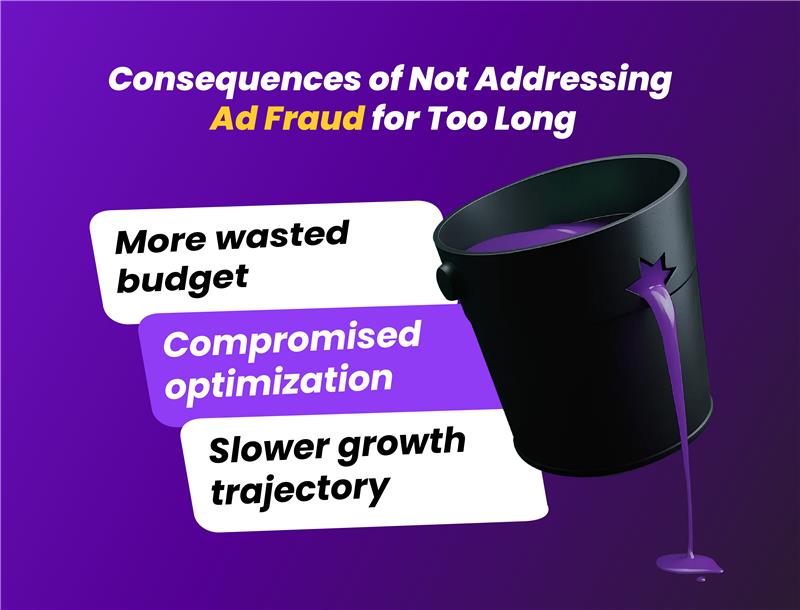
More wasted budget
Modern fraud techniques have grown incredibly complex and are easily able to surpass manual checks. This means that by the time an advertiser realizes they have fallen victim to fraud, they have already lost a significant sum of money in the form of their advertising budget. Without the implementation of an ad fraud protection solution, stopping this trend is almost impossible and the longer fraud goes undetected, the more significant the financial damage becomes. This drains the ad budgets that could have been allocated towards getting real, paying customers.
Compromised optimization
As mentioned earlier, instances of fraud can compromise the integrity of the ad performance data. This can lead to misguided optimization decisions that can further put your ad campaign results in a nosedive. Worse yet, skewed data can lead marketers to allocate their budget to fraudulent sources that deliver handsome numbers but no real results, while draining budget away from authentic lead sources.
Slower growth trajectory
With wasted ad budget and a compromised ability to optimize, it is not difficult to imagine how fraud slows down the growth trajectory of even the most well positioned businesses. Instances of fraud have the potential to inflate your customer acquisition costs and even impact other revenue metrics, affecting your brand’s ability to maintain sustainable growth.
Busting the Biggest Ad Fraud Myths
Myth: My MMP detects all fraud.
Reality: Mobile Measurement Parameters or MMPs do offer some security but are far from comprehensive. In fact, MMPs give advertisers a false sense of security as they often cannot detect or prevent complex forms of fraud like the use of device farms or sophisticated bots that mimic human behaviour.
Myth: Walled gardens are safe
Reality: While it is true that walled garden advertising ecosystems are relatively safer, even this notion is subjective. This is because such environments give advertisers access to very limited data, impeding their ability to verify the traffic and confirm that no instances of fraud have emerged. Moreover, even these highly secure platforms are prone to fraud attacks from fraudsters using fake accounts and sophisticated bots or engaging in manipulation of event signals.
Myth: MRC accreditation = safe
Reality: The Media Rating Council (MRC) accreditation is given to publishers that are able to meet a specific set of guidelines. While the accreditation is a good filter to shortlist publishers, it does not guarantee protection against ad fraud.
Myth: Fraud detection slows growth
Reality: Fraud detection doesn’t slow down growth, but the implementation of a fraud prevention solution may lead to a drop in ad performance numbers. However, this is usually because instances of fraud are eliminated. The “leads” that advertisers lose after the implementation of a fraud prevention solution are usually fraudulent that were never going to convert into a sale. Contrary to this myth, ad fraud prevention solutions promote sustainable growth and offer advertisers clearer insights that enable truly impactful optimization.
Myth: Fraud solutions are hard to integrate
Reality: This one is not so much a myth as it is the case of choosing the right solution. Today, advertisers have access to some great ad fraud prevention solutions that are built for speed, flexibility, and ease of use.
Check out the detailed infographic that busts the biggest misconceptions around ad fraud
How Can You Protect Yourself from Ad Fraud?
Protecting your brand and your ad campaigns from ad fraud requires vigilance and proactive measures. One key is to keep an eye on the red flags as mentioned above. And another way is to adopt a full funnel, post bid focused ad fraud solution.
What to Look for in an Ideal Ad Fraud Validation Solution? (By Source Type)
Choosing the right ad fraud solution is critical to ensure your advertising budgets are spent on real users, not bots or manipulated traffic. Below are the key features you should look for:
| Source | Must-Have Features |
|---|---|
| App | Click-to-install validation, OEM traffic filters, retargeting verification |
| Web | Bot filtering, lead validation, organic poaching detection |
| CTV/OTT | Viewability tracking, MFA site blocking, placement integrity |
| Affiliate | Source transparency, brand safety controls, sophisticated blacklisting |
What Sets mFilterIt’s Ad Fraud Validation Solution Apart?
AI-ML Powered Fraud Detection
mFilterIt uses advanced artificial intelligence and machine learning models trained on vast datasets to detect abnormal patterns and behaviours. These models continuously evolve, identifying both known fraud tactics and emerging threats. By combining behavioural analysis with both deterministic and heuristic checks, the system flags suspicious activity. In most cases, before any damage is done, turning fraud detection process from reactive to proactive.
Unlike traditional fraud detection technology, that work on 1×1 tags providing limited campaign insights and low confidence signals like referral URLs or IP addresses that can be easily spoofed, our click fraud protection tool works on JavaScript Tags and VAST tags, which help give a holistic coverage, providing deeper insights into traffic quality, user behavior, and potential red flags.
These tags evaluate traffic based on 70-80 parameters including location, device type, session patterns, and viewability metrics, etc. JavaScript tags are snippets of code embedded on a website or video player that collect a wide range of data points, such as ad visibility, page content, screen dimensions, browser details, user interaction patterns, and potential obstructions. This rich dataset plays a crucial role in accurately identifying and flagging fraudulent activity.
Real-Time Post back Blocking to Stop Payouts to Fraudsters
Stopping fraud after it happens isn’t enough. mFilterIt empowers marketers with real-time post back blocking that stops fraudulent conversions from reaching attribution platforms. This feature ensures that payouts are not mistakenly made to fraudulent affiliates or networks. It not only saves money but also cuts off the incentive structure that fuels the fraud ecosystem. With instant post back communication to MMPs and ad platforms, fraudulent events are blocked at the source, making it an active defense mechanism rather than a passive reporting tool.
Device Fingerprinting and Early Warning Systems
Fraudsters constantly change devices, reset IDs, or use emulators to spoof activity. mFilterIt’s advanced device fingerprinting technology creates a unique device signature or identifier based on multiple parameters like screen resolution, OS version, IP behavior, browser, time zone, font, etc. This lets our system detect device-level anomalies and behavioural patterns that indicate fraud in real-time, such as excessive installs or clicks from a single fingerprint across campaigns. This helps advertisers stay vigilant proactively on all traffic activities before fraud scales, enabling faster action and less revenue loss.
Full-Funnel Protection
Our proprietary solution helps detect and combat fraud at each stage of the campaign funnel. It covers the whole user journey, from click or impression to install, registration, and in-app/web events. Unlike solutions that only analyze top-of-the-funnel signals, we track fraudulent activity across the entire journey to provide deeper insights into the quality and integrity of ad traffic. For app campaigns, we verify MMP data, event triggers, and install anomalies. For web campaigns, we validate browser behavior, form fills, and conversion signals, etc. This layered visibility enables not just fraud detection, but smarter optimization based on clean, verified data.
Source-Level Validation
Understanding where your traffic is coming from is equally important to identify fraud. Our ad traffic detection solution provides source-level validation that links fraudulent events back to specific publishers, sub-publishers, and platforms. This granular level insight helps brands take targeted actions, like blacklisting unwanted sources or renegotiating contracts with affiliates or partners based on data-driven evidence. By tying fraud signals directly to traffic sources, marketers get actionable intelligence that helps reduce repeated offenses and increase accountability within their ad supply chain.
Omnichannel Coverage
Ad fraud happens on each platform. Bad actors use various techniques to manipulate the ecosystems, hijack traffic, and earn money through wrong means. mFilterIt’s solution offers omnichannel coverage, validating ad traffic across mobile apps, web, OTT, CTV, and even affiliate networks. This unified approach ensures that fraud is caught wherever it may occur, without leaving any blind spots. Whether you’re running a multi-market ecommerce campaign or a targeted app install campaign, our solution gives you a centralized view of traffic integrity, helping you maintain consistent performance and protection across all digital touchpoints.
Brand Safety
Looking at the ever-evolving digital ecosystem and AI-generated threats, it is also important for businesses to focus on brand safety along with fraud detection and prevention. mFilterIt addresses both by integrating advanced mechanisms. Our solution doesn’t just stop at verifying invalid traffic, it also ensures your ads aren’t displayed in harmful, inappropriate, or non-contextual environments that can hurt brand reputation.
Our solution uses contextual, sentiment analysis, and content intelligence to monitor where your ads appear, blocking placements that do not align with your brand values. It also verifies placements based on regional content and context for linguistically diverse audiences.
So, while our fraud engine filters out bots, click farms, and spoofed traffic, our brand safety layer keeps your ads off controversial or misleading content. This dual protection ensures that your marketing efforts are not just efficient, but also ethically aligned and reputation safe. The result is a cleaner, safer, and more trustworthy advertising environment that protects both your budget and your brand integrity.
Learn why marketers need a full-funnel protection approach to ensure brand safety
Real Cases of Brands Improving Their Ad Performance with Clean Traffic
Don’t just take our word for it. See how real brands tackled ad fraud using our advanced AI-ML based ad fraud detection tool. These case studies reveal the difference clean traffic can make when it comes to better attribution, higher ROI, and more efficient campaigns.
How We Helped Italy’s Leading Online Pharmacy Marketplace Improve Marketing Efficiency
1000Farmacie, one of Italy’s largest digital pharmacy marketplaces, had all the signs of a successful performance strategy – 1M+ retail customers, 800K+ annual orders, and strong affiliate traction. But behind the promising metrics, the real picture was far more complex.
When we at mFilterIt stepped in, our full-funnel fraud detection and validation tools quickly revealed what standard analytics couldn’t:
- 28% of affiliate traffic was flagged as invalid, coming from click spamming, cookie stuffing, and other fraud techniques.
- A large chunk of website visits displayed non-human behavior, such as, origination from data center IPs and zero user interactions like mouse movement or scroll
- Misattributions at the order level further distorted ROI, misleading budget decisions.
To address this, we implemented our end-to-end ad traffic validation and fraud prevention strategy, which included:
- Automated blacklisting APIs, directly integrated with their ad platforms
- Real-time session validation, tracking anomalies from visit to conversion
- Omnichannel dashboards for complete visibility across paid and affiliate media
- Continuous optimization, helping the team reduce invalid traffic and restore attribution accuracy
By validating 5.7M visits and identifying 20% of misattributed affiliate conversions, we helped 1000Farmacie identify the true performance picture.
The Outcome: Efficiency, Accuracy, and Growth
Our efforts delivered a 10% boost in affiliate efficiency, blocked 300+ fraudulent sources, and gave the brand control over where and how their budgets were spent, transforming affiliate marketing into a trustworthy growth engine, backed by clean, reliable data.
With mFilterIt’s support, 1000Farmacie not only protected its brand reputation but also optimized digital investments to drive real growth. This collaboration reinforced their commitment to customer trust and sustainable success.
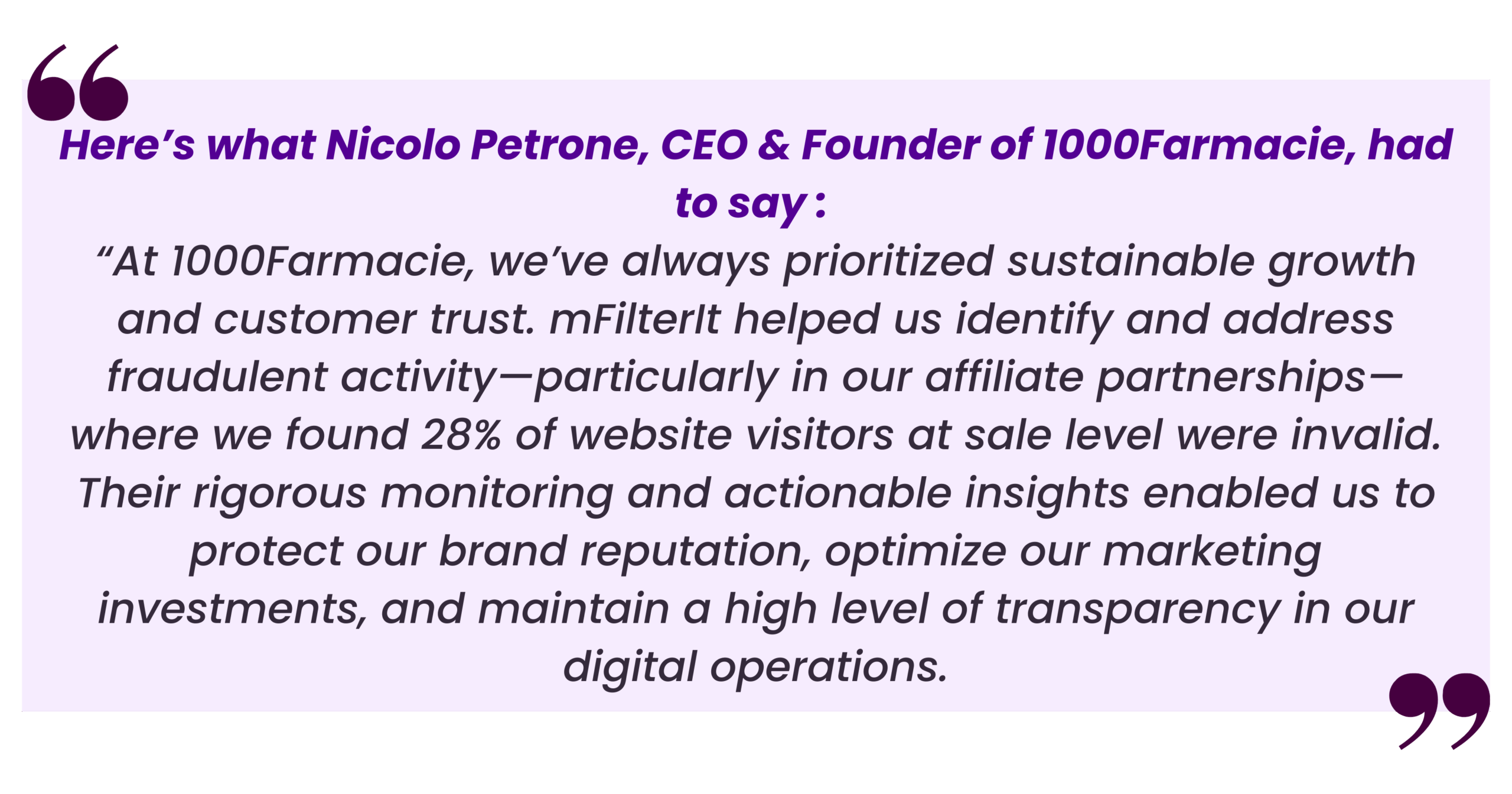
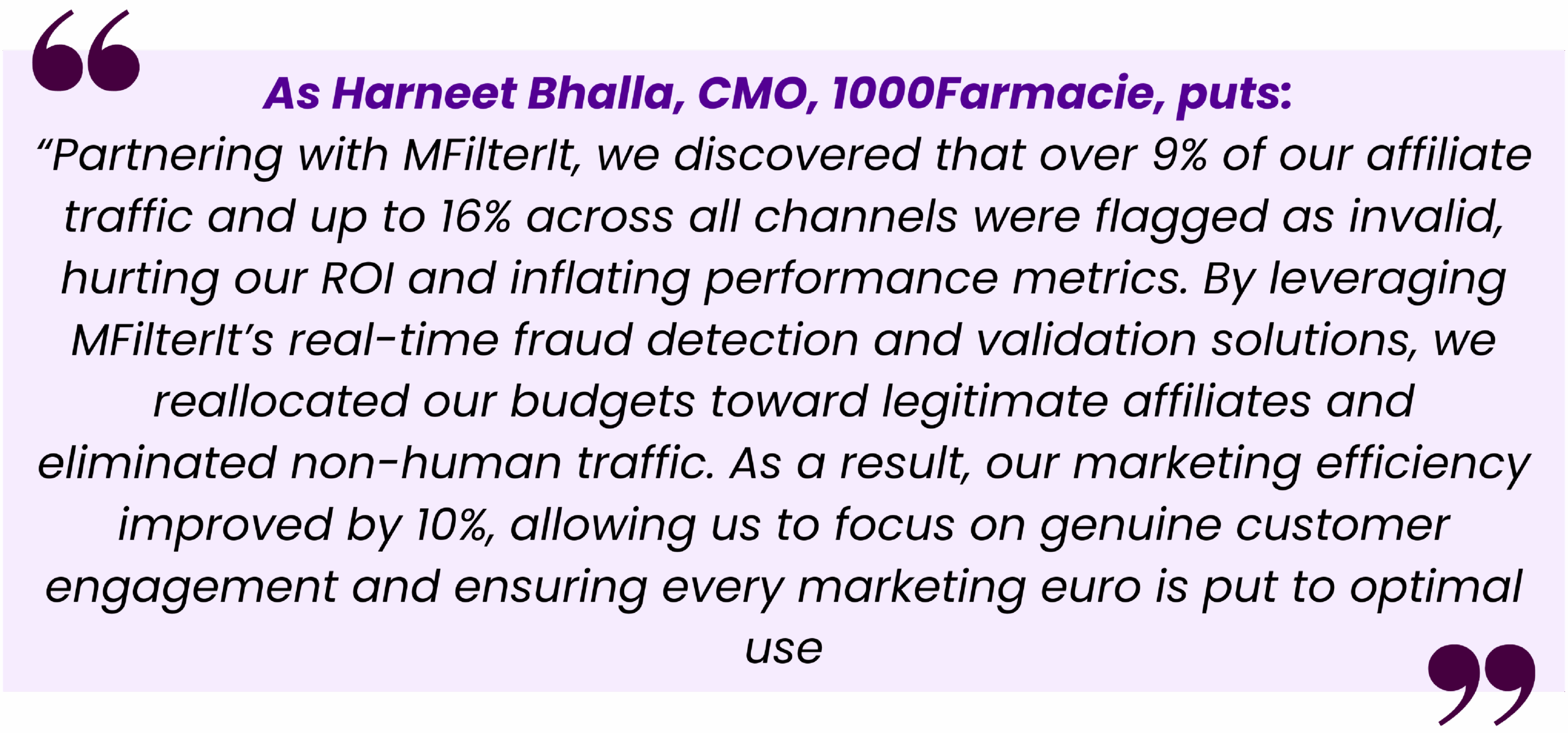
Read the detailed case study here
Another Case in Point: Kuku FM’s App Installs Were High, But Real Engagement Was Missing
Kuku FM, one of India’s top audio platforms, was investing heavily in app install campaigns to expand its user base. But while install numbers looked impressive, there was a glaring disconnect, most installs weren’t converting into meaningful actions like subscriptions or content engagement.
When Kuku FM came to us with the problem, our advanced fraud detection solution uncovered the real story behind the numbers:
- A large volume of installs came from APK sources with zero post-install activity, indicating junk installs designed to manipulate attribution.
- Click spamming from certain publishers led to inflated click counts but no value-added engagement.
- Incent traffic was bringing in users motivated by rewards rather than interest, resulting in low LTV and poor app retention.
To resolve these issues, mFilterIt deployed a comprehensive app traffic validation stack, including:
- Fraud pattern detection, identifying non-genuine installs based on behavioral anomalies.
- Monitoring of incent walls, helping flag and remove low-quality affiliates.
- Attribution cost audits, helping reduce MMP fees by eliminating fake installs from billing.
The Outcome: Cleaner Traffic, Better ROI, Smarter Spend
With our solution in place, Kuku FM gained full transparency into its traffic sources, blocked invalid publishers, and significantly reduced attribution costs, saving over ₹26 lakhs in the process.
The result was a more accurate view of performance and a reallocation of budget toward high-quality, engaged users. By shifting focus from quantity to quality, Kuku FM improved both ROI and campaign effectiveness, turning insights into actionable outcomes.

Check out the detailed case study to know more
FAQs: Common Concerns Addressed
Can it be implemented with my current ad tech stack?
→ No. mFilterIt integrates effortlessly into your existing ad tech stack. Implementation takes just a few minutes, and our team of experts is prepped and ready to facilitate the same.
Will I still hit my growth goals?
→ Yes. In fact, our partners typically see 30–40% better ROAS. This is thanks to the elimination of bad leads and instances of fraud while lets you focus your budget and efforts on high quality leads that convert into well-paying customers.
Will this reduce my reach?
→ Typically, our customers do see a drop in reach but in 100% of such cases, this drop is because of the elimination of bot traffic or traffic coming from other fraudulent sources. In other words, only the bad traffic is cut. Your real users stay and convert better.
Conclusion: Clean Ads. Real Growth
When it comes to the impact of ad fraud, the wasted budget is simply the tip of the iceberg. Stalled revenue growth, distorted metrics, and damaged trust in the brand are all hidden but equally pressing concerns associated with ad fraud.
This means that prevention doesn’t simply prevent wastage of ad spend, it boosts revenue growth and consumer trust in the brand, it helps the creation of a transparent and reliable digital ad ecosystem.
The elimination of fraud will lead to an ad experience where data can be trusted without doubt and growth is reflected in the business’ bottom lines and not just in skewed ad performance metrics. In other words, implementation of ad protection solutions isn’t just a safeguard against fraudsters, it is a growth strategy to outperform the competition that still operates unaware about the plague of ad fraud.
Ready to see the real picture behind your traffic? Uncover hidden ad fraud, optimize your campaigns, protect your ad budget, and brand reputation backed by data-driven insights only with mFilterIt

